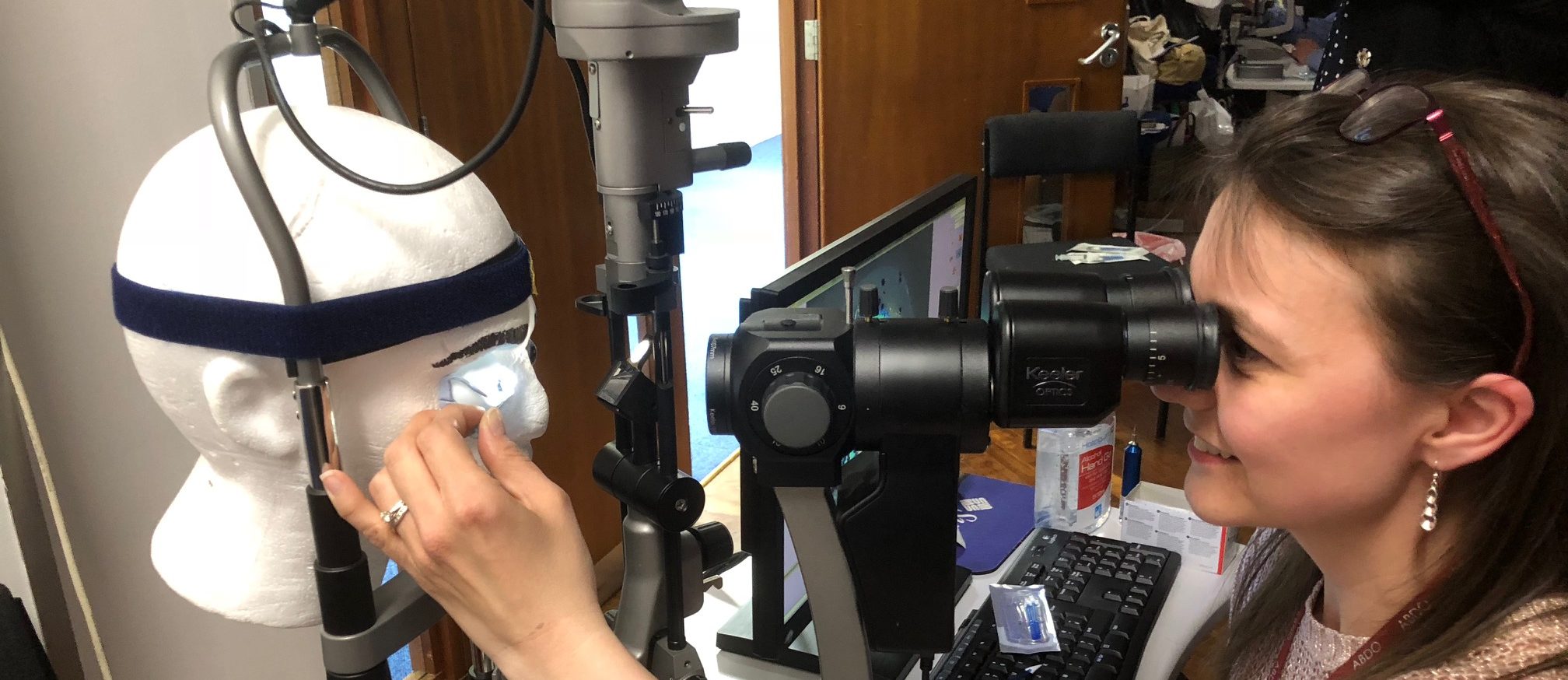
Course content
WOPEC and LOCSU distance learning lecture series
Courses available
- Minor eye conditions service (this content also covers the competencies for CUES) 7 lectures, 7 CET points.
- Glaucoma repeat measures 4 lectures, 4 CET points.
- Low vision theory LOCSU, 10 modules.
In development
- People with Learning Disabilities
To complete the training programme please follow the instructions outlined below.
A WOPEC Promo Code is needed for each of these lecture series. They are a unique authorisation code issued specifically to one person for a particular course or event. Promo codes also activate access to MCQ assessments.
ABDO Members should contact Max Halford using the form below to request an access code.
- Register or Sign-in yourself on the WOPEC website
On the top toolbar choose either to ‘Register’ or ‘Login’. At the registration page, enter the personal information requested. We would be grateful if you could also take a few minutes to answer the small number of questions. If you are registering for the first time, you will be sent a validation email. Follow the instructions on the validation email to validate your account. If you do not receive this please first check your spam folder. If it is not in your spam folder contact technical support.
- Register yourself on the course – Distance learning lectures
In the green ‘Code’ box on the website’s homepage enter your unique authorisation code. This will be made of two parts, a prefix (example: ABDO) and a code (example: 1234567).
PLEASE ENSURE YOU REGISTER FOR THE CLO VERSIONS OF THE COURSES.
Overview
Contact lens optician (CLO) MECS/CUES training and accreditation comprises a three-part process, part 1 and 3 provided by WOPEC and part 2 by ABDO in collaboration with WOPEC:
Part 1 Theoretical on-line training and accreditation.
Part 2 Practical training sessions (mandatory).
Part 3 Practical assessments using WOPEC CLO MECS specific templates.
Part 1: Theoretical Training and Accreditation provided by WOPEC
Summary
- 11 on-line distance learning lectures, each has 12 MCQs
- CET approved for 11 non-interactive CET points
- Web-page to upload MCQ answers
- Individualised CET certificate (in PDF format)
- Individualised WOPEC CLO course certificate on completion of all parts (in PDF format)
Lectures
There are 11 on-line lectures:
- The red eye
- Flashes and floaters
- AMD Part 1
- AMD Part 2
- The cornea and corneal foreign bodies
- Sudden loss of vision
- Dry eye in optometric practice
- Glaucoma and the optic disc assessment
- IOP and tonometry
- Visual fields and glaucoma
- NICE guidelines and practical techniques
Lectures last between 40 and 60 minutes and 1 CET point is available for each. The method of assessment is 12 multiple choice questions (MCQ) per lecture. Pass rate for each lecture is set at 60 per cent. In order to participate in the practical training session, all 11 Part 1 lectures must be successfully completed at least 3 days before the practical training event.
Outline of CLO MECS/CUES training and accreditation Part 1 distance learning lectures
A practice-based approach is used in this lecture presentation to assess and manage a patient presenting with a red eye. The lecture aims to alert the practitioner to the typical signs and symptoms of different causes of a red eye.
Management options for the common causes of red eye are also discussed with particular emphasis on those causes of red eye which are amenable to primary care practitioner management without the need for further referral.
A practice-based approach is used in this lecture presentation to assess and manage a patient presenting with flashes and floaters. The lecture reviews the anatomy of retinal detachment, the causes of flashes and floater symptoms, what to ask patients, what to look for, the techniques to use and the management applicable to a MECS practitioner.
This lecture presentation reviews the prevalence and risk factors for AMD. It then goes on to outline the anatomical changes that occur in Dry and Wet AMD and the clinical signs that result. The investigation techniques that a MECS/CUES optometrist should employ as part of revised protocols are then described with an emphasis on differential diagnosis with other conditions and of treatable and non-treatable AMD.
NB: CLOs would not be expected to perform any posterior eye examination techniques
A practice-based approach is used in this lecture presentation to assess and manage a patient presenting with a white lesion of the cornea or a superficial corneal foreign body. The lecture reviews the anatomy of the cornea and its unique defensive mechanism against microbes. A signs and symptoms approach to differentiating between an infected or non-infected corneal lesion is presented as well as useful techniques to aid differentiation and the management applicable to a MECS practitioner in these circumstances. Superficial foreign bodies are presented in a similar way with particular emphasis on methods that are useful to manage superficial foreign bodies in practice.
Practice-based approach is used in this lecture presentation to assess and manage a patient presenting with sudden loss of vision in a white eye. The lecture aims to provide a guide to interpreting the signs and symptoms of different causes of a sudden loss of vision. Each likely cause of loss of vision is discussed with particular relevance to the signs and symptoms. Optometric management as applicable to a MECS practitioner is outlined.
A practice-based approach is used in this lecture presentation to assess and manage a patient presenting with dry eye. A review of the cornea and tears is presented with an evidence base. The lecture reviews the evidence about numbers of patients with dry eye, the causes of dry eye and treatment with therapeutic drugs and other treatments.
This presentation provides the practitioner in primary care with training on glaucoma and optic disc assessment which is in line with NICE and Association of British Dispensing Opticians guidelines on the diagnosis and management of chronic open angle glaucoma (COAG) and ocular hypertension (OHT).
NB: CLOs would not be expected to perform any posterior eye examination techniques
This presentation provides the contact lens optician in primary care with training on IOP and tonometry which is in line with NICE guidelines on the diagnosis and management of chronic open angle glaucoma (COAG) and ocular hypertension (OHT).
This presentation provides the contact lens optician in primary care with training on visual fields which is in line with NICE guidelines on the diagnosis and management of chronic open angle glaucoma (COAG) and ocular hypertension (OHT).
This presentation provides the practitioner in primary care with training on the practical techniques (Van Herick’s assessment of the anterior chamber (AC) angle, and applanation tonometry) in line with NICE guidelines on the diagnosis and management of chronic open angle glaucoma (COAG) and ocular hypertension.
You can find the learning outcomes are for the Extended Services Course here.
Part 2: Practical training day provided by ABDO in collaboration with WOPEC
A mandatory preparatory course of virtual lectures and face to face practical sessions and lectures, comprising:
- AC angle assessment
- Assessment of the anterior chamber (e.g. cells or flare)
- Goldmann applanation tonometry
- Calibrating the Goldmann applanation tonometer
- Ocular foreign body management and removal
Part 3: Practical assessment provided by WOPEC
The part 2 practical assessment is a series of Objective Structured Clinical Examinations or OSCEs. This is a type of examination used in medicine to test skills such as communication, clinical examination, and interpretation of results. Practitioners will be expected to perform a number of different tasks to demonstrate their overall clinical competence.
They are held under invigilated examination conditions and each station lasts seven minutes in total, the assessors are present at each station in an observatory capacity with a fixed assessing and marking criteria. There is no teaching element and it is not a viva.
Feedback or results are not given after each station.
Candidates are tested on the following skills:
- data interpretation
- clinical examination
- patient management of acute and chronic conditions
- referral
Conditions are drawn from those in the 7 distance learning modules that they will have recently completed:
- Wet and dry AMD
- Corneal conditions
- Corneal foreign bodies
- Retinal tears and detachments
- Posterior vitreous detachments
- Red eye
- Sudden loss of vision
- Dry eye
- Measuring IOP with a Goldmann applanation tonometer
- Calibration of a Goldmann applanation tonometer
Van Herick’s peripheral chamber depth assessment
The assessment is designed to assess whether a practitioner is able to safely and confidently perform MECS clinical examinations. In most stations marks are awarded for being systematic and well organised, confident, competent and polite to the patient. In each station the assessor will award a grade:
- Excellent
- Clear Pass
- Borderline Pass
- Fail
The WOPEC Lead assessor will email the practitioners their overall result within two weeks of the event. If necessary, they will also receive feedback relating to the assessment.
Wales Optometry Postgraduate Education Centre
School of Optometry and Vision Sciences
Maindy Road
Cardiff
CF24 4HQ
Telephone: 0292 087 0561
Email: WOPEC@cardiff.ac.uk
Website: www.wopec.co.uk
Association of British Dispensing Opticians
Telephone 020 7298 5100
Email general@abdo.org.uk
Website www.abdo.org.uk
Read the learning outcomes here.
Read the FAQ for the extended services for contact lens opticians here.
Extended services for contact lens optician
To access the online modules, fill in the form below to request an access code. By accepting an access code you will allow your details to be shared between ABDO and WOPEC
